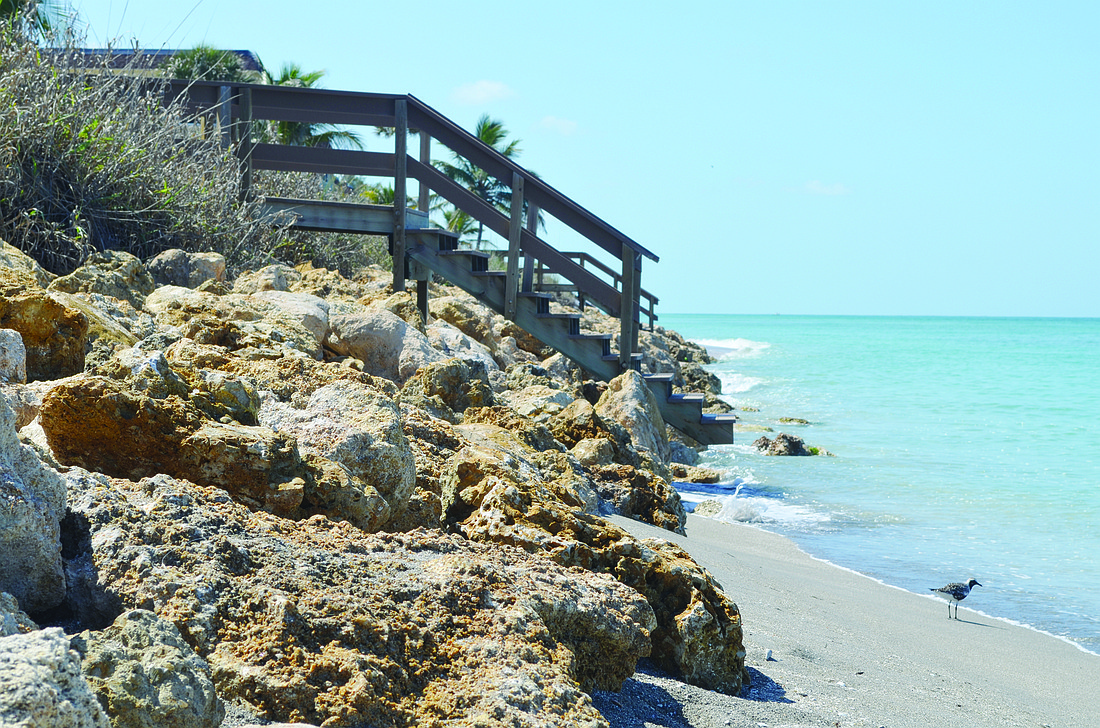- April 25, 2024
-
-
Loading

Loading

Joe Schmitt has walked to Casey Key from Siesta Key’s Turtle Beach along the Gulf of Mexico at least twice a week for the last 20 years.
“Sometimes I walk all the way onto Casey Key,” Schmitt said. “It depends how much energy I have.”
But his usual path along the Gulf of Mexico shoreline has become more treacherous since Fisherman’s Cove, located at 9000 Blind Pass Road, finished rebuilding a protective rock structure in April, and currents continue to suck sand away from the front of the property.
As concerned Siesta Key residents rally against plans to dredge Big Pass for sand to renourish Lido Beach, properties on the south end of Siesta continue to face erosion issues of their own. And the fix is still stuck in permitting limbo.
“Over the last few months we’ve lost the last little bits of beach,” said Fisherman’s Cove Rental and Property Manager Rhonda Holliday. The beach was renourished with more than 870,000 cubic yards of sand in its first phase in 2007, “but ever since then, Mother Nature has been taking it back,” she said.
But, with the designation of a migratory bird called the rufa red knot as a threatened species under the Endangered Species Act in December and changes to federal permitting requirements to protect loggerhead turtles, the county’s application is still waiting for federal approval.
“We got kind of a double-whammy,” said Sarasota County Coastal Initiatives Manager Laird Wreford. “We, like so many other renourishment applicants, are suddenly caught in this vice of waiting for the federal permitting issue to be resolved before moving ahead with the project.”
Schmitt said he understands the delay and Fisherman’s Cove’s need to bolster its shoreline with a bulkier rock revetment, but he just thinks it would be fair for the county to provide a sandy walkway over part of the rock structure, which existed prior to the latest wave of erosion.
“I don’t blame them a damn bit because they’re just protecting their property,” Schmitt said. “But we should all get along.”
Wreford said the county had roped off the former path because the tide swept the sand away and it has become too dangerous, though Schmitt said he just walks under the barrier.
Between nearby property owners being taxed to pay for the projects, environmentalists fighting against — or for — habitat protection and recreational users lobbying for use, Schmitt’s sentiment illustrates the difficulty in coordinating beach renourishment projects.
Also, the unpredictability of erosion patterns could change and Turtle Beach could actually start accreting sand, Wreford said.
“When we did last measurements, the actual rate was not getting worse,” Wreford said. “But, the erosion simply continues.”
As for Schmitt, luckily he knows someone who lives in the Fisherman’s Cove complex, so he doesn’t have to rely on walking the coastline to access one of his favorite fishing spots.
“You catch a lot of stuff,” Schmitt said. “But it seems like fishing is better when you go farther south.”
“We got kind of a double-whammy. We, like so many other renourishment applicants, are
suddenly caught in this vice of waiting for the federal permitting issue to be resolved before moving ahead with the project.”— Sarasota County Coastal Initiatives Manager Laird Wreford